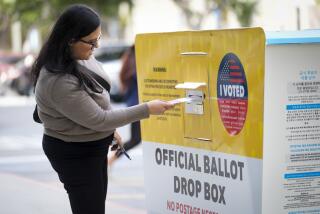ELECTIONS ’88 : ORANGE COUNTY : Answer to 2-Year-Old Coastal Cityhood Question Up to the Voters Now
- Share via
On June 7, voters in the communities of Dana Point, Capistrano Beach and coastal Laguna Niguel will have the chance to band together into one beachside municipality and become Orange County’s 28th city.
An incorporation proposal, known as Measure B, calls for combining the three communities into one 6-square-mile coastal city of about 25,000 residents. If it passes, the city of Dana Point will be born, following the lead of neighboring Mission Viejo, which became a city March 31.
The cityhood measure has attracted 23 residents from all three communities to run for a new City Council. If voters approve incorporation, the top five vote-getters would become the first City Council and take office when Dana Point officially becomes a city Jan. 1, 1989.
The issue of cityhood, which has stirred controversy for more than two years, has sprouted two citizens’ organizations, one on each side of the issue: Unpaid (United People Against Incorporating Dana Point) and the Dana Point Citizens for Incorporation.
Fred Jenner, spokesman for the pro-cityhood group, said the question voters ask most is: Will each of the three communities retain its identity?
Jenner’s answer: “Yes. Officially, all the city letterheads will say Dana Point, but the ZIP codes and names of the areas will all remain the same,” he said, explaining that they will always retain their neighborhood identities.
But the anti-cityhood group disagrees.
‘Shotgun Wedding’
“It has been put together in a shotgun wedding by LAFCO. They are politicians who live 25 or 30 miles away. . . . This (proposed city) is just stuck together with a paste pot,” said Jim Davy of Unpaid.
Originally, Dana Point and Capistrano Beach residents approached the Orange County Local Agency Formation Commission with separate cityhood proposals in late 1986.
However, by April, 1987, the commission determined that Capistrano Beach was not financially viable on its own and added it to the Dana Point proposal.
Then in May, 1987, when the cityhood proponents thought they were going to get the nod from the commission for an April, 1988, incorporation election, some residents in the coastal area of Laguna Niguel proclaimed that they did not want to be a part of a Laguna Niguel cityhood proposal that also was before LAFCO.
The commission called for an advisory election so the 3,444 registered voters within the 1.5-mile coastal strip could decide whether to incorporate with Dana Point or Laguna Niguel. In the Nov. 3 election, 61% of the voters wanted to be included in Dana Point’s incorporation proposal.
After the election, there were several heated commission meetings, at which hundreds of inland Laguna Niguel residents protested the panel’s decision to apply the advisory election results and give to Dana Point the coastal strip, which includes the Ritz-Carlton Hotel and represents about $2.5 million in annual revenue to the city.
The inland Laguna Niguel residents kept saying that developers have long promoted Laguna Niguel as “Sea Country,” referring to the community stretching from the San Diego Freeway to the coast, between Laguna Beach and Dana Point.
The Laguna Niguel Incorporation Task Force filed a lawsuit against LAFCO, charging it with violating the California Government Code, which requires the commission to consider how an incorporation will affect the areas adjacent to the proposed city.
The task force also filed a lawsuit asking the courts to declare the results of the June 7 election illegal, should voters approve cityhood for Dana Point.
The proposed city’s boundaries would stretch from the Pacific Ocean east to the border of San Juan Capistrano and Camino del Avion in Laguna Niguel, north to Laguna Beach and south to San Clemente.
The new City Council would have until July 1, 1989, to organize the city--choosing a city manager and other city personnel.
For those six months of transition, the county still would provide municipal services to the area, including police and fire protection, traffic and animal control, planning and land-use regulation, and street maintenance.
Dana Point intends to be a contract city, meaning it will contract with other agencies for most municipal services. The city would have a projected surplus of $3 million, based on financial feasibility studies.
Cityhood proponents contend that Measure B is the voters’ last chance to form a small city because local agency formation commissioners recently discussed the idea of making larger cities out of the vast unincorporated land remaining in the south county.
Tom Crump, of the pro-city group, said that if Dana Point doesn’t incorporate, the three communities risk being annexed by the surrounding cities of San Clemente, San Juan Capistrano or Laguna Beach, or included in a larger city that would include inland Laguna Niguel.
Annexing Sections
Crump said the neighboring cities have been annexing small sections of Capistrano Beach over the past two decades.
However, Davy said the proposed coastal-city area still would have a large voting block to prevent those things from happening.
“Politicians can manipulate boundaries, but we retain the right to vote,” Davy said. Measure A, the Citizens’ Sensible Growth and Traffic Control Initiative, which only affects the unincorporated areas, also has become an issue in the election.
If it is approved, it would apply to the proposed city of Dana Point because the area will be unincorporated until Jan. 1, 1989. At that time, the city will adopt the county’s ordinances--including the slow-growth initiative--as its own for at least 120 days. After that, the City Council has the option of continuing it.
“The City Council would have a chance to see how (Measure A) works and can change it or make its own plan,” Crump said.
‘Threat to Measure A’
But Davy said the anti-cityhood group supports Measure A and sees incorporation as a threat to the initiative because council members would have the opportunity to enact ordinances that differ.
“A vote for incorporation could possibly kill the beneficial results of the slow-growth initiative,” Davy said.
He also noted that the anti-cityhood group believes there is a silent majority of people against incorporation who will show up at the polls.
“Generally, a lot of people just don’t want another nit-picky layer of politicians,” he said.
But incorporation supporters believe it is time they had local representation instead of relying on one county supervisor representing a large district.
Said cityhood proponent Russ Marshburn: “It’s a chance to have one voice in 20,000 versus 1 voice in 200,000.”
DANA POINT CITY COUNCIL CANDIDATES
If the voters decide June 7 that Dana Point, Capistrano Beach and coastal Laguna Niguel should become one city, a City Council will be created. Hoping to fill the five seats are 23 candidates from the three communities.
Bill Bamattre
Occupation: Los Angeles Fire Department captain
Age: 36
Residence: 5 1/2-year Dana Point resident
Thomas R. Brabeck
Occupation: real estate broker
Age: 40
Residence: 19-year Dana Point resident
Ron Buchheim
Occupation: teacher at Dana Hills High School and property manager
Age: 41
Residence: lifetime Dana Point resident
Chuck Chapin
Occupation: administrator at Cal State Fullerton
Age: 32
Residence: five-year Dana Point resident
Judy Curreri
Occupation: public health nurse
Age: 45
Residence: 13-year Dana Point resident
Addison DeBoi
Occupation: engineer for Southern California Edison Co.
Age: 37
Residence: lifetime resident of area and now in Capistrano Beach
Mike Eggers
Occupation: businessman and congressional aide to Rep. Ron Packard (R-Carlsbad)
Age: 40
Residence: 16-year Dana Point resident
Harold R. Kaufman
Occupation: businessman, negotiator
Age: 46
Residence: four-year Dana Point resident
Bill Kennedy
Occupation: retired automotive specialist
Age: 70
Residence: 11-year Dana Point resident
Eileen Krause
Occupation: owner of an air pollution control company
Age: 44
Residence: 21-year Laguna Niguel resident
Geoffrey Lachner
Occupation: attorney
Age: 43
Residence: seven-year Dana Point resident
Margaret (Peg) Maynard
Occupation: immigration and naturalization attorney Age: 53
Residence: 10 1/2-year Laguna Niguel resident
Harold F. McGrath
Occupation: attorney and businessman
Age: 55
Residence: 15-year Laguna Niguel resident
Ingrid McGuire
Occupation: member of the board of directors of the South Coast Water District
Age: 56
Residence: nine-year Laguna Niguel resident
Fred Mellenbruch
Occupation: Realtor
Age: 41
Residence: one-year Laguna Niguel resident
Robert (Bob) Moore
Occupation: businessman
Age: 64
Residence: 12-year Laguna Niguel resident
Lynn J. Muir
Occupation: architect Age: 59
Residence: 36-year Dana Point resident
Howard Neufeld
Occupation: attorney
Age: 40
Residence: five-year Capistrano Beach resident
Louis Roberts
Occupation: attorney Age: 36
Residence: six-month Dana Point resident
Richard D. Runge
Occupation: county civil engineer
Age: 53
Residence: 18-year Dana Point resident
W. F. (Scotty) Smith
Occupation: retired aerospace supervisor
Age: 71
Residence: 15-year Capistrano Beach resident
Brian Valerie
Occupation: contract negotiator
Age: 37
Residence: six-year Dana Point resident
William Walker
Occupation: retired quality control manager
Age: 60
Residence: 5 1/2-year Dana Point resident
More to Read
Sign up for Essential California
The most important California stories and recommendations in your inbox every morning.
You may occasionally receive promotional content from the Los Angeles Times.










